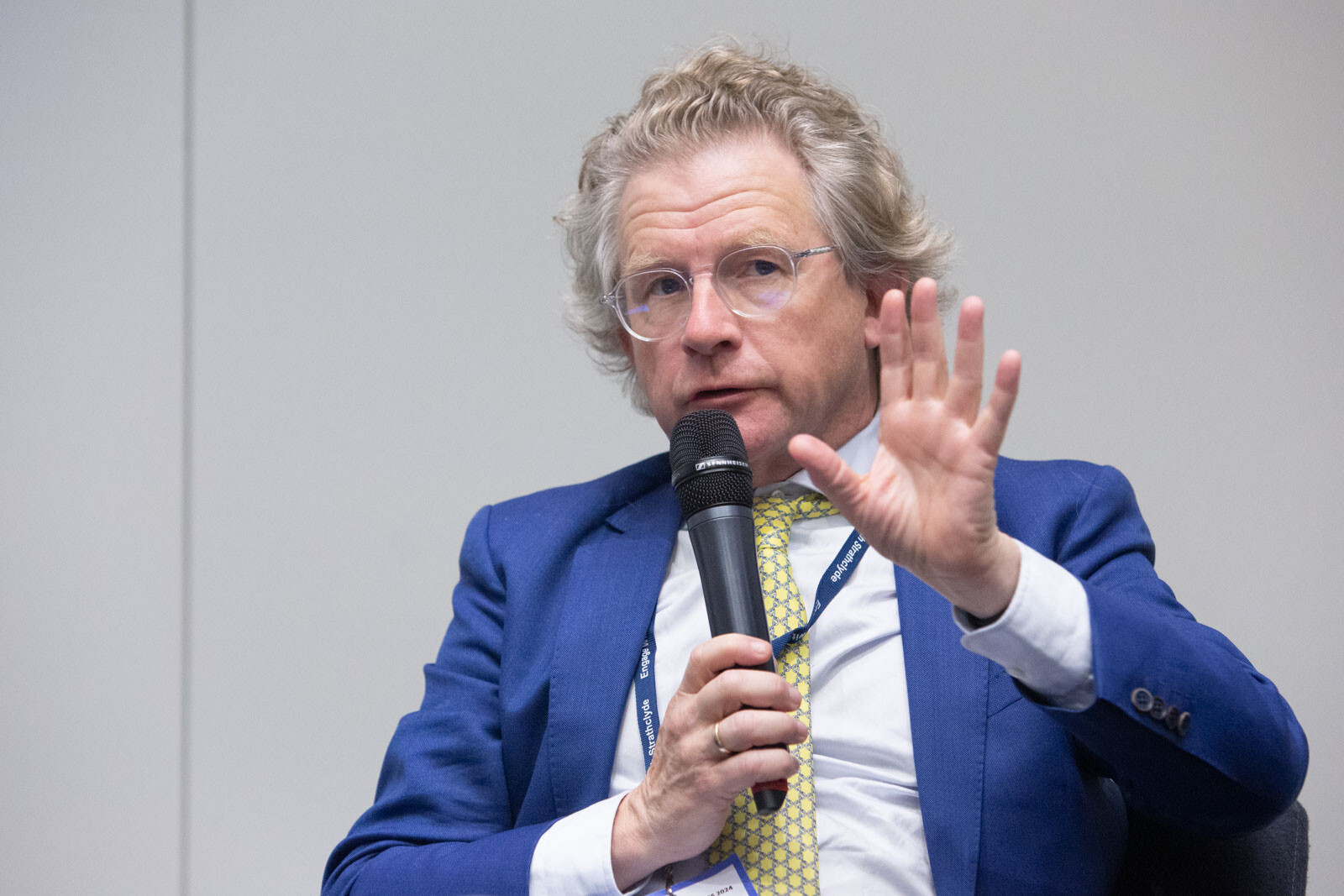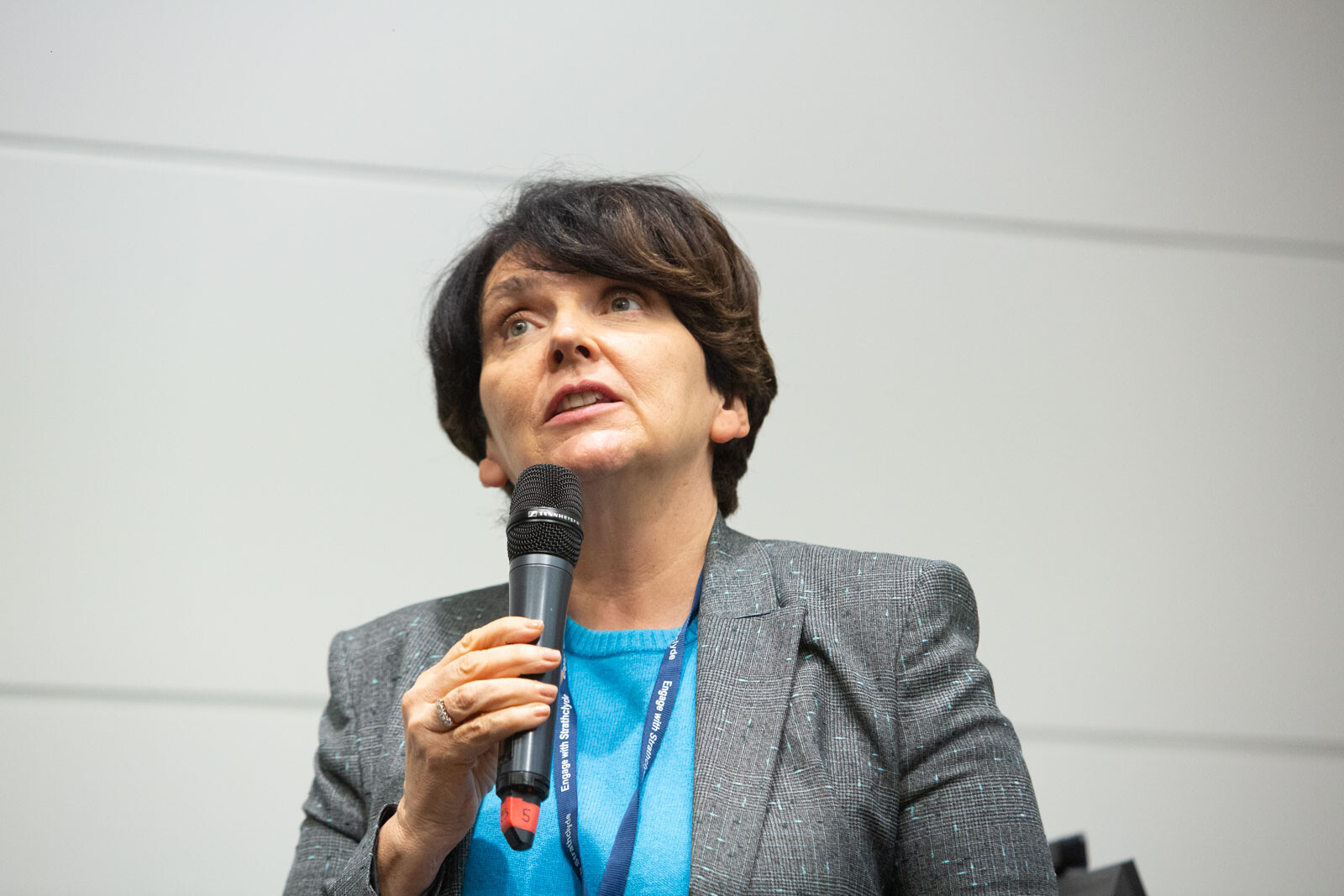On 17 October 2024, the University of Strathclyde in Glasgow hosted over one hundred and thirty participants for a high-level conference titled “Innovation districts – from deeptech and entrepreneurship to inclusive innovation.” This event, part of the CESAER Annual Meetings 2024, brought together representatives from universities, industry, and government to discuss the role of innovation districts in driving deep tech entrepreneurship, regional development, and societal impact.
Sir Jim McDonald, Principal & Vice-Chancellor of the University of Strathclyde, opened the conference by highlighting the importance of universities as central hubs of innovation within their cities and regions. He emphasised the significance of partnerships and collaborative efforts that leverage the “knowledge triangle” of education, research, and innovation to address societal challenges and foster resilience and competitiveness.
The conference began with a keynote address from Ben Johnson, Professor of Practice in Research and Innovation Policy at the University of Strathclyde and former Senior Policy Advisor to the UK Minister of Science and Technology, who provided a UK perspective on innovation systems and regional growth strategies. This was followed by a video keynote from Signe Ratso, Deputy Director-General for Research and Innovation at the European Commission. who shared insights into the European Union's approach to supporting innovation ecosystems. Manuel Heitor, Chair of the high-level expert group on the future of the European framework programme for research and innovation and CESAER Envoy, then delivered remarks on Europe’s strategic direction for fostering deep tech and inclusive innovation.
The next session began with a keynote speech by Jane Martin, Managing Director of Innovation & Investment at Scottish Enterprise, who highlighted how Scotland’s innovation strategy leverages deep tech ecosystems to drive economic growth and societal impact. She emphasised the critical role of innovation districts in creating environments that attract global companies while nurturing local startups, thereby positioning regions as leaders in cutting-edge technologies.

Following the keynote, a panel, moderated by Jennifer Herek, Vice President of CESAER and Dean of Faculty of Science and Technology at University of Twente, explored how innovation districts are harnessing the knowledge triangle—education, research, and innovation—to drive entrepreneurship and societal impact. The panel featured prominent invited contributors including Jane Martin; Martin Kern, Director of the European Institute of Innovation and Technology (EIT); Chris Johnson, Chief Scientific Adviser at the UK Department for Science, Innovation and Technology; and Marie-Anne Lebrec, Director of Projects Innovation and Entrepreneurs at Télécom Paris, Institut Polytechnique de Paris.
Discussions ranged from the role of regional ecosystems in fostering collaboration between universities and industry to strategies for scaling deep tech startups within innovation districts. Panellists emphasised how these districts can not only generate economic growth but also serve as engines of societal innovation, bridging the gap between academic research and real-world applications. It was mentioned by various panellists that these local hubs play a crucial role in linking businesses and universities, both locally and internationally.
“These hubs on the ground are the glue of innovation ecosystems, connecting businesses and universities locally and internationally.”
– Martin Kern, Director of the European Institute of Innovation and Technology (EIT).
Key factors for successful innovation districts included the importance of connecting institutions and adopting a global perspective to help create successful and leading innovation districts. Marie-Anne Lebrec emphasised the value of diverse collaboration, stressing that both informal and formal exchanges between various stakeholders are essential for a thriving ecosystem. She highlighted the urgency of creating a shared vision to support incubators at different stages and accelerate the development of spin-offs that can push innovation forward.
“Let the innovation be creative, give it the room to be creative. We must work together and think collectively.”
– Marie-Anne Lebrec, Director of Projects Innovation and Entrepreneurs at Télécom Paris, Institut Polytechnique de Paris
Another important message was the need to address skills gaps in various technologies, with universities of science and technology playing a key role in fostering broad technological skills, while innovation districts being crucial for targeting specific needs and contributing to filling the remaining skills gaps.
Lastly, it was highlighted that the character and ambition of residents and people within these innovation districts are vital for its success. Therefore, instilling ambition, courage, resilience, and self-confidence in young people throughout their education is key. Additionally, the placement of the districts is key to ensuring successful innovation that involves the full knowledge triangle. A collective approach, combined with pride, ambition, and an international mindset, is crucial for achieving outcomes that surpass individual efforts.
“Innovation districts are not only about technology and regulation, but more so about the character of the people who live there.”
– Chris Johnson, UK department for Science, Innovation and Technology Chief Scientific Adviser
In the next part of the conference, Michiel Scheffer, President of the European Innovation Council (EIC), delivered a keynote on the crucial role of universities of science and technology in driving regional development and inclusive innovation. He highlighted the need for innovation efforts to address societal needs and contribute to sustainable growth, especially through deep tech solutions.

Following the keynote, a panel discussion moderated by Tim Bedford, Vice President of CESAER and Associate Principal at University of Strathclyde, delved deeper into how universities can act as key players within innovation districts. The invited panellists—Mads Bang, Innovation Director at Aalborg University; Ana Avaliani, Director of Enterprise at the Royal Academy of Engineering; Federica Rosetta, Vice President, Academic and Research Relations at Elsevier; and Michiel Scheffer—focused on how universities can act as drivers of innovation within their regions.
The discussion started on the evolving concept of “4th Generation Universities” (4GU). Federica Rosetta pointed out that traditional rankings often overlook universities' broader impact on regional innovation. To address this, the 4GU project, was initiated to explore new ways to define universities' roles within their regions. CESAER in 2018 published a seminal white paper on the topic of the role of universities of science and technology in innovation ecosystems, and our association has therefore been invited to be a key contributor in this new 4GU project. Federica Rosetta invited CESAER Members to help co-create new indicators and join the expanding 4GU community, with the support from the Task Force Benchmark and Task Force Innovation.
Michiel Scheffer highlighted the potential of the 4GU concept, suggesting that its connection into the upcoming European Innovation Act and European Research Act—envisioned to be developed by Commissioner-designate Zaharieva—could help address the diverse roles of universities across Europe, including fostering regional networks and promoting democratic values among young people.
Mads Bang reflected on Aalborg University’s journey on its 50th anniversary, emphasising how the university has significantly boosted regional GDP and employment through research and startup activity, showcasing the long-term impact of sustained university-industry collaboration.
Ana Avaliani shared the UK Royal Academy of Engineering’s approach to fostering innovation by engaging closely with regional communities. She emphasised the creation of enterprise hubs aimed at strengthening local ecosystems across the UK. Avaliani also stressed the importance of maintaining connectivity at local, national, and global levels, and tailoring support to regional needs.
''When it comes to innovation, it's not just about your local ecosystem; it's also about the national ecosystem and global reach.''
– Ana Avaliani, Director of Enterprise at the Royal Academy of Engineering
In discussing how to build an effective and inclusive innovation ecosystem, Bang highlighted the importance of understanding what motivates researchers to contribute to innovation activities while addressing barriers such as regulatory constraints. Scheffer emphasised the need for universities to prioritise strategically, focusing on the real needs of their regions and society. Avaliani stressed that education fosters entrepreneurial mindsets, highlighting that inclusive innovation often emerges from interdisciplinary collaboration, and this transition from engineers to entrepreneurship can be supported by enabling resources like infrastructure and lab spaces. Rosetta concluded by highlighting the potential future direction of the 4GU concept, embracing collaboration across all types of knowledge creation also beyond technical disciplines, to drive regional development.
''The choice of focus is crucial. Many universities tend to concentrate on areas that are wise from a capitalist point of view but neglect social needs. Currently, the large healthcare portfolio of the EIC is largely aimed at addressing issues affecting a small segment of the population—primarily wealthy older men, with less attention towards other groups such as cancers primarily affecting much younger parts of the population. We need universities to engage with individuals from all walks of life, conduct ground-level research, and integrate these insights into their research and innovation programs.''
– Michiel Scheffer, President of the European Innovation Council (EIC)
The conference concluded with closing remarks by Orla Feely, President of CESAER and President of University College Dublin, who underscored the importance of continued collaboration between universities, industry, and broader society. She emphasised the need for fostering innovation that benefits all parts of society.
This edition of the CESAER high-level conference reaffirmed the pivotal role of innovation districts as platforms that support deep tech entrepreneurship and inclusive growth and societal impact, aligning with both European and global innovation goals.

We use both our own cookies and those of carefully selected partners we collaborate with.
Check out our detailed Cookie policy » and our Privacy policy » .